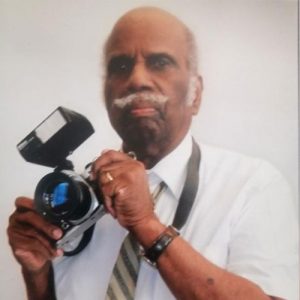Journalism and COVID-19: Remembering Theodore Gaffney
This journalist profile is part of Journalism and COVID-19: The Toll of a Pandemic, PEN America’s project covering the toll of the coronavirus crisis on the journalism industry in the United States. Our hearts go out to the family members and friends of the journalists lost during the pandemic.

Photo courtesy of Maria Santos-Gaffney
Name: Theodore Gaffney
Age: 92
Died: April 12, 2020
Location: Washington, D.C.
Work History:1Ian Shapira, “He risked his life photographing the 1961 Freedom Riders. Theodore Gaffney just died from the coronavirus at 92.” The Washington Post, April 16, 2020.
- Freelance photographer; was most well-known for documenting the Freedom Riders’ journey for Jet magazine and became one of the first African American photographers to take photos inside the White House
- Amphibian truck driver and M-1 rifle sharpshooter, United States Army
Selected Remembrances:
“Theodore Gaffney’s presence in the civil rights movement remains one of the most recognizable – even though he was always behind the scenes. Gaffney captured much of the historic events of the era as a photographer.”
—Kenya Evelyn, Breaking News Reporter, The Guardian [The Guardian]
“In his 92 years, Theodore Gaffney witnessed some of the most consequential moments in history.
“He served in the US Army during World War II. One of the first black photographers in the White House, he took photos of US Presidents Harry Truman, Dwight Eisenhower, John F. Kennedy and Lyndon B. Johnson, as well as Queen Elizabeth II.”
—Harmeet Kaur, Producer, CNN [CNN]
“He provided proof that black people are being assaulted at these protests. We’ve lost a tremendous wealth of knowledge who actually lived many of the things we are documenting.”
—Lopez Matthews, Digital Production Librarian, Howard University Libraries and the Moorland-Spingarn Research Center [The Guardian]
“He was interested in documenting the struggle of people of African descent here in the U.S. He would say, ‘If you don’t believe you can change things, you won’t know until you try.’”
—Maria Santos-Gaffney, wife of Theodore Gaffney [TIME]
“In the spring of 1961, Jet magazine asked Theodore Gaffney, a Washington freelance photographer, to travel with the Freedom Riders, a group of activists from across the country who planned to challenge segregation in the South by riding Greyhound and Trailways buses. . . He found himself risking his life and documenting one of the most tumultuous 48 hours in civil rights history.
“Gaffney’s own history helped make him the perfect person to chronicle the civil rights movement. He was the descendant of people who had been enslaved at a plantation near the town of Gaffney, S.C.”
—Ian Shapira, Enterprise Reporter, The Washington Post [The Washington Post]
“Gaffney ended up with a front-row seat to one of the most significant events of 20th-century American history. The Freedom Riders, who traveled the American South to challenge the segregation of buses and terminals, revealed American injustice to the world, charted a course of nonviolent action that would lead to the Civil Rights Act of 1964 and galvanized a new generation of civil rights leaders. Along the way, they were met by vicious mobs and eventually federal intervention. And Gaffney was there to capture it all.”
—TIME Staff [TIME Magazine]
Selected Work:
- May 15, 1961: Freedom Rider Jim Peck talks with a Justice Department representative and Ben Cox on the “freedom plane” to New Orleans [via NPR]
- [Unknown date]: C. T. Vivian (left) and Diane Nash (center) lead the Nashville Freedom Riders [via National Endowment for the Humanities; Amy Lifson, author of the piece, confirmed that all photos credited to the Johnson Publishing Company were taken by Gaffney]
- [Unknown date]: Freedom Riders Jim Peck and Charles Person sit next to each other on the Freedom Riders’ bus [via National Endowment for the Humanities; Amy Lifson, author of the piece, confirmed that all photos credited to the Johnson Publishing Company were taken by Gaffney]
- [Unknown date]: Image “seen around the world” after segregationists attacked and burned down the Freedom Riders’ bus in Alabama [via Tyler Clifford on Twitter]
- [Unknown date]: Photo on display at the Freedom Rides Museum in Montgomery, AL shows a Klansman attacking a photojournalist [via Andrew Maraniss on Twitter; in a reply to the tweet, Stacy Strazis wrote that Gaffney was the journalist on the ground who took the photo]






